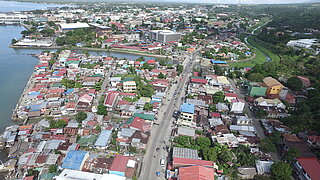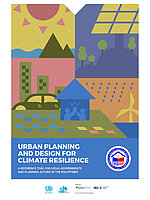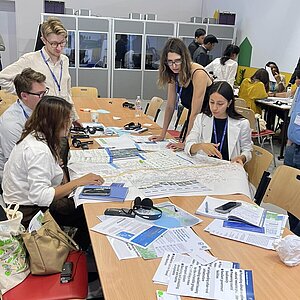Urban planning for climate change

An IKI project in the Philippines is supporting risk prevention and the adaptation of cities to climate-related extreme weather.
According to the Global Climate Risk Index 2021, the Philippines is one of the countries most at risk from climate-related extreme weather events around the world. The impact of climate change on this island state in Southeast Asia is considerable: severe weather regularly results in casualties and fatalities, while also causing high levels of economic losses and damage to key infrastructure.
Urban regions, which generate 75 percent of the country’s gross domestic product, are especially exposed to the jeopardising effects of climate change: 70 percent of cities in the Philippines are situated along the coastline, where they are directly affected by tropical hurricanes, storm surges, flooding, coastal erosion and high winds. The impacts of climate change that occur at a slower rate, such as sea level rise and global heating, are also having serious consequences.
Roughly half of the Philippine population now lives in urban areas. The United Nations (UN) and the Philippine Government have estimated that this proportion is set to rise to 60 percent over the next 20 years. This means that even more people will be exposed to the impacts of climate change if cities do not take action as a matter of urgency. The poorer classes in society are at particular risk because they typically live in high-risk areas. These districts, often consisting of ad hoc dwellings without resilient infrastructure, are affected more profoundly because of their location – near rivers, for example.
IKI project supports urban climate resilience in the Philippines
Funded by the International Climate Initiative (IKI), the project ‘Climate-resilient urban planning: support for municipal authorities in the Philippines’ is helping to accelerate urban adaptation. As part of this undertaking, UN-Habitat is working with the Philippine Department of Human Settlements and Urban Development (DHSUD) and other regulatory authorities to devise suitable policy measures together with sustainable urban development plans and urban construction models.
The project is supporting the National Climate Change Action Plan as well as the further development and implementation of the country’s Nationally Determined Contributions (NDCs). As cities continue to grow in size, institutional capacities need to be built up at both national and subnational level. In order to help shape and foster the Green Recovery following the Covid-19 pandemic, and to promote the use of low-carbon and resilient principles and practices, the project received top-up funding of EUR 700,000 from the Corona Response Package.
Training for ministries and public administration
Part of the project has involved further training for 50 planning trainers as well as policymaking staff working at the Department of Human Settlements and Urban Development, the Department of the Interior and Local Government (DILG), and the National Economic and Development Authority (NEDA). The aim here is to ensure that local governments are able to accommodate the necessary adaptation to the impacts of climate change as part of urban zoning and sector planning. Technical staff from the Climate Change Commission (CCC) and the urban platform League of Cities of the Philippines (LCP) also received training to help them support local authorities in developing city plans and designs compatible with climate change.
Pilot cities offer a learning space for testing know-how and measures
Five pilot cities have been used as a test bed for knowledge transfer and trialling practical measures. The cities of Angeles, Cagayan de Oro, Legaspi, Ormoc and Tagum are working here with planning experts from the national institutions to implement the principles of climate-resilient urban design.

The City of Ormoc offers a concrete example of practical measures to adapt to the impacts of climate change. In this port city in Leyte province, citizens have cooperated directly with the project as part of technical design ‘charrettes’. This charrette process is a public-sector participative planning method for urban and regional development. Local planning experts worked together with citizens to develop urban planning measures along the banks of the Malbasag River and in Can-adieng barangay. These measures include linear parks and redesigned open spaces that, as floodwater catchment areas, increase air exchange while also helping to improve urban temperature regulation. Sustainable drainage systems for handling torrential rain events, semi-natural dikes and buffer zones plus the construction of more resilient subsidised housing were all defined by the charrette process.
These plans offer examples of how to cushion the Philippines against the impacts of future extreme weather events and protect those of its citizens living in urban centres. At the same time, these plans improve the quality and reliability of water supplies, transportation, recreational facilities, public health and also improve soil conditions. The benefits are felt not only by the 1,856 inhabitants directly affected by this planning: the measures also contribute to the overall resilience of the city as a whole.
With the support of the IKI project, the Department of Human Settlements and Urban Development is also improving its guidelines for urban planning and its training programme for local governments. The adaptation of urban systems has been anchored in place at various levels, ranging from local construction work to the design of barangays, and the layout and structure of entire cities. Particular focus has been given here to existing blue and green infrastructure – i.e. to riverine and parkland areas. Urban construction planning has also integrated climate adaptation regulations in order to promote the implementation of corresponding measures.
Better evaluation of climate risks
The work of this project has similarly improved the analysis of current and future climate risks. In this respect, the DHSUD has updated and expanded its guidelines for the Climate and Disaster Risk Assessment (CDRA), a tool used by local governments to assess potential climate and disaster risks. As an important addition, this tool now also considers the long-term consequences of climate change such as extreme heat and sea level rise. The improved version also accounts for the interplay of health and climate risks, because the IKI project has also been focusing on climate-related health and pandemic problems for some time now.
The updated guidelines simplify decision-making and the planning of climate mitigation measures while also incorporating strategies for a Green Recovery following the Covid-19 pandemic. Thanks to cooperation with the relevant govern
This article is part of the IKI Annual Report 2020 - Active for International Climate Protection. For more information, please visit the special page on the IKI Annual Report 2020.
The link has been copied to the clipboard
Contact
IKI Office
Zukunft – Umwelt – Gesellschaft (ZUG) gGmbH
Stresemannstraße 69-71
10963 Berlin
Related Publications
-

-
 05/ 2023 | Tool/Open source product
05/ 2023 | Tool/Open source productUrban Planning and Design for Climate Resilience: A Reference Tool for Local Governments and Planning Actors in the Philippines
English (PDF, 116 MB)








![[Translate to English:]](/legacy/_processed_/5/5/csm_Indien_EE_Solar_Frau_bfcf99c425.jpg)